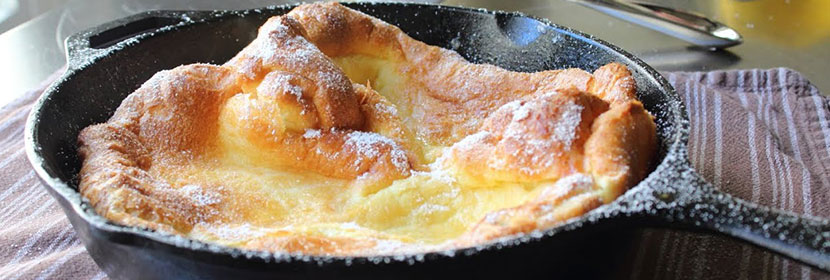A Dutch baby (or Dutch baby pancake), is also known as a German pancake, a Hootenanny, a Dutch puff, or a Bismarck, and is simply a large American popover.
A large Yorkshire pudding shares a lot of similarities with a Dutch baby. A Dutch baby is usually baked in the oven. This is different from a typical pancake, which is always fried on both sides on the stovetop. A Dutch baby is also relatively thicker than many pancakes. It also consists of zero chemical leavening ingredients like baking powder.
Although the thought of a Dutch baby pancake might have come from the German Pfannkuchen, the present form originated in the United States in the early 1990s.
More About the Origin
Various reports indicate that Dutch babies were originally introduced in the first half of the 90s at Manca’s Cafe. This was a family-run restaurant that belonged to Victor Manca and was situated in Seattle, Washington.
And although these pancakes are typically obtained from the German pancake dish, it’s believed that one of Victor Manca’s daughters coined the name Dutch baby. As you might know, the term “Dutch” was most likely her corruption of the term Deutsch, a German antonym. According to Manca’s Cafe, they owned the Dutch babies’ trademark in 1942.
How Are Dutch Babies Made?

Are you interested in knowing what the ingredients are? And, what does the preparation process entail? Read on.
Dutch babies are made with eggs, milk, sugar, and flour, and are often seasoned with cinnamon and vanilla. However, fruit or any other flavoring is sometimes included. A basic batter usually includes 1/3 cup of milk per egg and a 1/3 cup of flour.
It’s usually baked in a metal pan or hot cast iron and deflates after it’s removed from the oven. It’s often served with butter, freshly squeezed lemon, powdered sugar, syrup, or fruit toppings.
How Does It Rise Like That?
So, how do these pancakes get all puffy like that?
The heat in the oven usually starts to set the egg proteins and gluten on the batter’s surface, and this surface tension creates a shell or flexible bubble. As the pancake’s outer shell hardens, the water within the batter converts to steam and looks for a way out but can’t. The pancake then inflates like a balloon because of this trapped steam.
It typically bakes in a wide and shallow pan. Therefore, it cooks faster at the edges that are in contact with the skillet’s hot sides. This leads to a puffy edge as well as a thinner custardy center.
How to Serve
Most people prefer the pancake when it’s served with powdered sugar, a bit of maple syrup, and perhaps a squeeze of lemon.
More so, you can serve it with strawberry slices, apple slices (some restaurants and recipes will consider baking them in the batter), jam, blueberries, and raspberry juice. Furthermore, you might like a smear of a bit more butter on the pancake.
Do you want to try out a Dutch baby? Are you in the Coeur d’Alene, Post Falls, Liberty Lake or Spokane area? Then The Old European Restaurant can serve you! Apart from offering made from scratch dishes, they serve them with love and smiles!



Comments are closed.